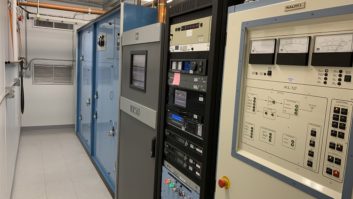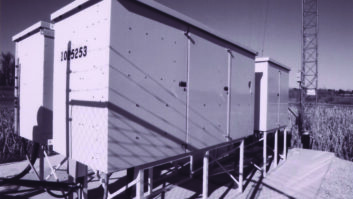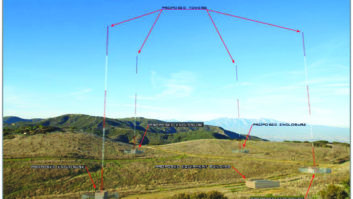Tower light monitoring is still high on the “hit lists” of the FCC and the FAA.
The interface Ray Fantini provided for tower light telemetry caused John “J” Harris at KUAC(FM) in Fairbanks, Alaska, to drag the following circuit from his files.
For the price of a few active components and a wall-wart power supply, you can get a cyclic flash indication and a logic LOW when the flash fails. You can also use this logic LOW to give you a log printout when the failure occurs.
J’s circuit has worked several years without problems, and he still has the board artwork, if any reader would like it. Send a self-addressed, stamped envelope to J. Harris, KUAC, Box 755620, Fairbanks, Alaska, 88775. KUAC is licensed to the University of Alaska.
The motivation to develop this circuit was vandals shooting out the tower lights. The transmitter site is semi-remote, which provides a great place for teen parties. After one occurrence, soon after last year’s 9/11 disaster, the FBI got involved. Law enforcement’s first question is “when?” Connecting the circuit to a printer and logging any outage will record the time of the event. Although no one was apprehended, the circuit “lies in wait” for the next time, should it occur.
(click thumbnail)Fig. 1 With a few components and a wall-wart, you can get a cyclic flash indication and a logic LOW when the flash fails.
Fig. 1 shows the schematic of the circuit. The interface conditions the pulse from the tower light pickoff, and provides a buffered “flash out.” The 555 is a missing-pulse detector, which gives a logic LOW when the pulses do not arrive within the period set by R1 and C1. The values of R1 (200 kohm) and C1 (47 ufd) set a period of about 13 seconds.
The LEDs used in the circuit provide a visual indication for the flash pulse and the flash fail. The transistors can be any small-signal transistors. J chose Q1 to be a NPN 2N4401, and for Q-2, a PNP 2N4403. The circuit can be mounted on a 2-by-2-inch breadboard, nice and compact.

. . .
(click thumbnail)Fig. 2 The electrical box on the left was the focus of concern for an inspector at KVRI(AM).
Mike Gilbert had the responsibility of building a new 50 kW directional site for Multicultural’s KVRI(AM) in Blaine, Wash. The site is diplexed with KARI. The construction of the doghouses to house the antenna tuning units for the towers brought an interesting challenge. The electrical inspector required a non-conductive shield to be constructed between the RF network and the electrical box.
The inspector reasoned that if someone working on the electrical box on the left in Fig. 2 were shocked or fell, the wooden shield would prevent them from falling into the RF network on the right.
(click thumbnail)Fig. 3 The fix, a wooden shield, also supports a shelf for the dehydrator.
Fig. 3 shows a bonus the wooden shield provided: support for a shelf for the dehydrator. Note also the conduit leaving the building, to the lower left of the dehydrator. Mike sealed the entry with expanding foam, and guarded against vegetation growth by graveling the outside of the building, as seen in Fig. 4. Keeping the conduit inside the tower fence, before it goes underground, also protects against vandalism.


. . .
Don’t overlook a hobby store for unique parts. When putting together test cables, small flat alligator clips can be useful in tight places. The biting or “action” portion of the clip is flat, instead of serrated. Before broadcast users discovered them, these clips were used to clamp onto the leads of model rocket engine squibs.
(click thumbnail)Fig. 4 Expanding foam and gravel protect the building from flora and fauna.
Hobby shops have a wide variety of lubricants, glues and graphite compounds. The latter become useful now that cooler weather prevails.
Make sure your fence and tower locks get a spritz of liquid graphite or lock lubricant to keep the internal mechanisms working. A number of years ago, I saw a neat use of tire rubber inner tubes. A square piece of this rubber was cut and slipped over the lock hasp, or in the case of locked buildings, mounted on the wooden frame.
The rubber would collect the ice and snow and protect the lock. Because the inner-tube rubber was flexible, shaking it would remove any ice, giving you instant access to the lock.

. . .
In cooperation with the U.S. Consumer Product Safety Commission, Fluke Corp. voluntarily is recalling about 40,000 digital multimeters. About 17,200 of these meters were sold in the United States. The recalled units take longer than normal, up to 18 seconds, to display readings of AC voltages above 500 volts. Users can misinterpret the delayed reading to mean that high voltage is not present. If high voltage is present, users can be exposed to a risk of shock, electrocution or thermal burns.
The meters are identified by the name “Fluke” and the model numbers, 175, 177 or 179 written on the front. Recalled meters have serial numbers below 79,000,000. Consumers should stop using these meters immediately, and call Fluke at (800) 260-4819. You may also visit the Fluke Web site at www.fluke.com/170recall .
A picture of the recalled products can be seen at the Consumer Product Safety Commission’s site www.cpsc.gov/cpscpub/prerel/prhtml02/02231.html
Submissions for this column are encouraged, and qualify for SBE recertification credit. Fax your submission to (703) 323-8044, or send e-mail to [email protected].






